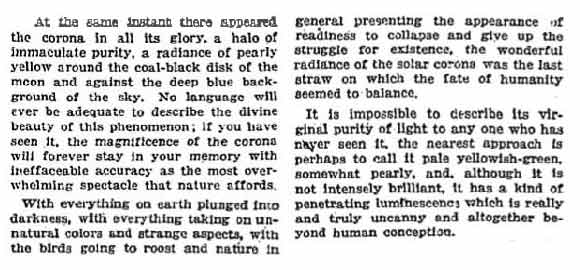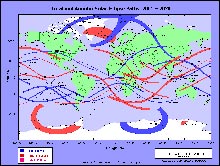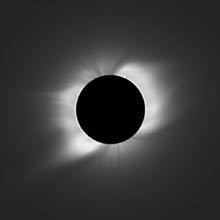
October 25, 2008
It lasts only a few minutes. It is available not even once a year, and then, as often as not, only in the Earth’s most remote, inhospitable places. Yet it provides such uncanny transports that people will travel to the ends of the Earth, sparing no expense or trouble, to obtain it. Its name would be right at home among the code words for other powerful psychedelics: eternity, gold dust, beautiful, black star, the truth.
Totality.
You haven’t really lived until you’ve experienced a total solar eclipse. That’s the first message I took away from Joe Rao’s October feature about chasing last August’s umbra through the Arctic in an airplane, “Shades of Glory,” and from the accounts of other totality witnesses that I came across in the course of fact checking—a process that left me with a bad case of eclipse envy. The second message that came through loud and clear was: beware! This is not something you can just put on your bucket list to do once in your life and be satisfied. It’s addictive. If you’ve seen one, you’ll want to see them all.
This was, in fact, Joe’s tenth total eclipse, and he’s a piker compared with the organizer of his polar air expedition, astronomer Glenn Schneider, of the University of Arizona’s Steward Observatory: August 2008 was his twenty-seventh. He first experienced “the privilege, and joy, of being immersed in the Moon’s umbral shadow” in 1970. From all those years, all those trips, he has distilled precisely one hour, sixteen minutes, and thirty and one-tenth seconds of the elixir of Totality. The scarcity of the experience no doubt sharpens the craving. But (or so I imagine) it is the sheer sensory strangeness of coming face to face with the vast reality of our solar system—the Sun not just the workday’s giant light bulb, the Moon no flat lovers’ cutout—that sets the hook.
Schneider is perhaps Totality’s most ardent pusher, its Owsley, as it were; he not only advocates “umbraphilia” but enables it. Schneider has created and made available free Mac software, UMBRAPHILE, that will not only enable you to plot the track and then count down the seconds of any total eclipse, but, if you have the chops to set up a camera or video interface, will take “hands-free” photos for you. At that link are some astounding photographs—and stories—of such far-out “trips” as “Siberia, 1997!” and “Zambia, 2001!”
But Schneider has lots of company. Take a look at Bill Kramer’s Web site, Eclipse Chasers, and particularly at the e-zine titled, fittingly, TOTALITY! (unbeknownst to me until after this post was written), which lets you share in eclipse expeditions and conferences, meet the most prominent eclipse scientists and enthusiasts, and plan your own journey up to ten years ahead. The current issue (PDF) chases the August 1, 2008, umbra all the way along its track, from Nunavut, Canada across the high Arctic to Siberia, Mongolia, and China, via firsthand accounts from many points along the way.
If you can’t chase eclipses, while waiting for one to come your way (to be safe, become a vampire; the umbra should revisit every place on the globe, on average, once every 375 years), reading the rhapsodic prose they inspire is really next best. Unlike video, words can transport you inside the experience and give you a glimmering of its eerie awe. Again, Glenn Schneider [repeat link] is one of the best purveyors of the vicarious as well as the real thing:
Glenn Schneider is an UMBRAPHILE. Literally a “shadow lover”, but properly applied, one who is addicted to the glory and majesty of total solar eclipses. Those who have basked in the moon’s shadow will know what I mean without further explanation. Those who have not may have difficulty in understanding that umbraphillia is not only an addiction, but an affliction, and a way of life. The real raison d’ etre for many of us. . . . Once every 16 months, or so, (on average) umbraphiles will drop whatever they are doing and trek by plain [sic], ship, train, foot, and camel-back to gather along a narrow strip in some remote God-forsaken corner of the globe defined by the inexorable laws of celestial mechanics. . . . Wherever the solar photosphere will be extincted, enshrouded by the ashen lunar disk, umbraphiles will revel in the quasi-twilight darkness.
Shades of “the slithy toves/ did gyre and gimble in the wabe.” Starting to feel that contact high yet?
Joe Rao is writing both in a venerable tradition of total-eclipse “trip journals,” arguably going back as far as the Old Testament, and in a newer but well-established tradition of viewing the phenomenon from the air [a PDF of Glenn Schneider’s 2007 talk, with many images, a large file: 52 Mb]—both because of the thinness and clarity of the high atmosphere, and because a moving airplane can at least briefly track the umbra (which sweeps across the Earth at more than a thousand miles per hour at the equator and twice as fast at the poles), prolonging the taste of totality by precious seconds or minutes. (The late lamented Concorde once bagged a decadent 74 minutes of totality, almost as much as Glenn Schneider’s entire 39-year accumulation.) The two traditions have converged before, notably in 1925, when the New York Times commissioned then twenty-six-year-old Harvard astronomer Willem J. Luyten to view that year’s East Coast total eclipse from a Red Baron-style airplane (one of twenty-five that went up to see, in addition to the dirigible Los Angeles) and report it on the front page.
The Times is still profiting from this vintage drug—at $3.95 a pop—but here’s a free sample:


It always comes back to this: You hadda be there.
Luckily, your next chance to experience Totality comes unusually soon: next summer—Wednesday, July 22, 2009. But you’ll have to be in India, Nepal, Bangladesh, Bhutan, Myanmar, China, or Japan’s Ryukyu Islands to catch it. Glenn Schneider is already packing for Wuhan, China.
[O]f course everyone is talking about the mid-Pacific where totality will be longer than any TSE for more than a century, or China (to be on terra firma) where it is only a little shorter. . . . I plan to observe the eclipse from Wuhan, and if all goes well with the weather (so not having to relocate due to clouds) will be on the grounds of Wuhan University (Biotechnology Institute). I will be joining a band of like-minded umbraphiles there, on a group tour organized by Rick Brown (“another ecliptomaniac”), as he describes here.

There will be a ship, actually more than one. . . . At least one (the Costa Classica) is headed for the point of maximum eclipse, and trying to do so with extreme precision. I was recently contacted by Roy Mayhugh, who is on the organizing end of that . . . to assist with some calculations to enable that in detail (including for example
taking into account the velocity of the ship, the details of the irregular lunar limb profile (totality can be extended a few tenths of a second by going OFF centerline), etc.).

For myself, though, for TSE2009 I prefer to be on dry (and steady) land. I have had mixed success photographically with eclipse imaging in 1973, 1984, 1998, 1999, and most recently in 2005. For that most recent shipboard eclipse (no choice, it did not cross land ANYWHERE just the Pacific Ocean over open water), I did use a gyro stabilized imaging platform. However, we were moving at 14 knots to dodge clouds (and JUST did, thankfully, the sun clearing the clouds DURING second contact), with cross winds that saturated the stabilizing capacity of the gyros. That is why there are no outer corona (long exposure) pictures of that eclipse on my web site here, which shows that gyro setup. Being on firm ground obviates that particular problem. For TSE2009 I plan again to field my “lug-o-scope,” which I used for TSE2006, and that produced results that are hard (if not problematic) to obtain from shipboard.
The next time Totality sweeps across the United States will be August 21, 2017, and then again almost seven years after that:
The path of totality will extend from the Pacific Northwest to the southeast. Totality will reach the coast centered on Salem, Oregon, though Portland will be just out of totality to the north. It will pass Kansas City and Nashville and Knoxville, Tennessee, reaching the east coast including Columbia, South Carolina’s 2½ minutes of totality. . . . [T]he total solar eclipse of April 8, 2024, will cross the United States from central Texas to northern New England, including such cities as Austin and Dallas (Texas), Cleveland (Ohio), Erie (Pennsylvania), and Buffalo and Rochester (New York).
Have a great trip!
More Eclipse Goodies
- For you vampires, complete information on eclipses of “the centuries to come”—and of those gone by—is on NASA’s comprehensive eclipse Web site.
- Dmitri Mendeleev, the discoverer of the periodic table of elements (and quite a character), was the first to observe a total solar eclipse from the air—from a hot-air balloon (PDF), which rose above the clouds obscuring the eclipse from the ground, August 19, 1887.
- The first sight of an eclipse from an airplane (PDF)—June 8, 1918, out of Fort Sill, Oklahoma—nearly killed
pilot and passenger, both military men.
- New York Times accounts of the 1925 airplane flotilla and dirigible trip are also available pay-per-view, for less than a rock of crack.
- How a solar eclipse confirmed (and World War I clouded over) Einstein’s theory of relativity.
- Eclipses have quite a few other scientific uses as well.
- Milestones in our understanding of the Sun . . .
- But there’s still so much we don’t understand.



(Annie Gottlieb) |
Comments (add yours!)

Return to September-October home
|






